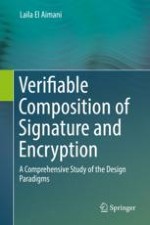2017 | OriginalPaper | Buchkapitel
3. Analysis of StE
verfasst von : Laila El Aimani
Erschienen in: Verifiable Composition of Signature and Encryption
Aktivieren Sie unsere intelligente Suche, um passende Fachinhalte oder Patente zu finden.
Wählen Sie Textabschnitte aus um mit Künstlicher Intelligenz passenden Patente zu finden. powered by
Markieren Sie Textabschnitte, um KI-gestützt weitere passende Inhalte zu finden. powered by
